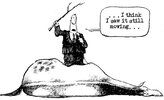TheIronWarrior
Well-Known Member
- Joined
- Apr 14, 2013
- Messages
- 423
- Reaction score
- 329
- Points
- 63
- Location
- Halifax, NS, Canada
Let's explore this a little, because I'm a nerd. Using information for the NC700 that I Googled.Plus you’d be leaving the power and behind likely resulting in slower acceleration than keeping her in the power and,
Looking at gears 3, 4, 5, and 6, the average upshift reduces your RPM to 83% of what you were in the previous gear (81% - 86%).
The average upshift will also reduce your wheel torque by the same percentage for a given RPM.
For example, if you were at 6700 RPM in 4th, an upshift would put you at about 5600 RPM in 5th.
Let's ignore losses from the drivetrain and consider wheel torque to be equivalent to engine torque factored by gear ratio (not strictly true, but if the losses are similar through all gears and speeds, ignoring them won't affect the conclusion that much).
6700 RPM in 4th puts about 207 ft-lb to the wheel. 5600 RPM in 5th puts about 201 ft-lb to the wheel.
If we assume the torque curve continues linearly beyond 6700 RPM (which is not true, so this will give an artificially HIGH torque) then torque at 7000 RPM in 4th would be about 195 ft-lb. An upshift puts us at 5800 RPM in 5th with a torque to the wheel of about 198 ft-lb. Somewhere between 6700 RPM and 7000 RPM, you get better acceleration by downshifting.
Note, where the lower gear changes (1-2, 2-3) have larger RPM drops, there might be a LITTLE to gain by over-revving, but not a lot of time is usually spent in 1 and 2.
The crossover point for 2-3 is between 7300 and 7600, and around 7900 for 1-2. Again, remember the post-6700 RPM Torque values are artificially inflated, so the actual crossover point will be at a lower RPM that we determined here.
TL



